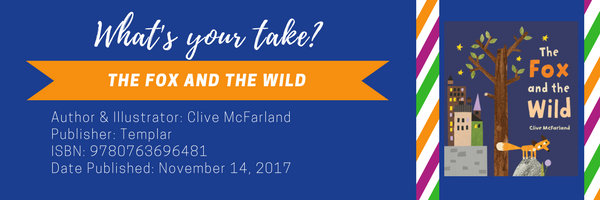
Several members of our group serve on literature award committees and noticed that in 2017 publishers released some interesting books about foxes. We wondered if the representation or characterization of the fox changed from the traditional portrayal as a sly personality in trickster tales, classics like Aesop’s Fables, Pinocchio and Three Little Pigs, or modern tales like Fox (Margaret Wild and Ron Brooks) and Rosie’s Walk (Pat Hutchins). Are fox characters more empathetic in recent publications such as Pax (Sara Pennypacker and Jon Klassen)? In week 1, we discuss The Fox and the Wild by Clive McFarland.

SUSAN: A young fox lives in a city that is noisy, smoky and dangerous. When he and his cousins raid some garbage cans, the fox is chased to a rooftop where he notices birds flying. He wonders where they are going and has the chance to ask a frightened goose after assuring her that she will not be his next meal. He sets off asking other city animals about the “wild” where he heard there are trees, hills and wind. When he escapes another close call by running through a drainage tunnel, he discovers the wild on the other side. He also discovers another fox who, seeing a bird flying, asks him where he thinks the bird is going–and the story ends with a question, inviting the reader to ask, wonder and explore.
As I read the story, there are several themes that stick out. One is the idea of letting animals live in ways that are natural to their habits. The fox seems out of place in a noisy, smoky city. Somehow I do not think of foxes as city dwellers because they do not seem like scavengers. It seems natural that a fox wants to find the wild.
The more important theme and connection I make to the story is the tendency to dream of somewhere else–a.k.a. wanderlust, curiosity, wondering what is beyond the horizon. For that reason I love the story. The fox keeps asking animals and exploring his city, determined not to give up until he finds a more satisfying place to live. I also like the way he keeps comparing the description of the “wild” furnished by the goose with the scenery he explores. His city environment does not match the checklist. The bird’s description pushes him to explore.
MEGAN: I enjoyed the story and the greater theme of adventure and, as you hit on, more explicitly exploration. Stories that encourage individuals to explore the world around them both locally as well as nationally and globally are beneficial to education and learning. The fox is well versed in what life is like in the city and soon learns what life is like outside of the city. Living in different places allows individuals to learn different perspectives and ways of being. This story could be used to demonstrate the disconnect someone may feel when they are not in their native surroundings. As you stated, foxes are not naturally city dwellers, and therefore he may have a comfort issue with his surroundings. This could be parlayed to humans and the all too common phenomenon of relocating. I relocated twice while growing up. One of my relocations was simple though the other (in junior high) was more dramatic. My own children relocated at least a half dozen times while growing up. Relocating has advantages and disadvantages. I think the advantages ultimately outweigh any disadvantages.
From a writing standpoint this story also has a lot of possibilities–from writing an ending to writing the next chapter in the fox’s life.
At first I thought the fox in this tale is different from how I remember foxes portrayed in my youth. The fox in this tale is curious and determined, but he is also polite and courteous to everybody he encounters. When I think of foxes, I tend to lump them together with wolves, which is incorrect, but I imagine that occurs frequently. The point being that wolves are traditionally bad guys (e.g., Little Red Riding Hood and The Three Little Pigs) and I immediately think of foxes in the same light. Then I began to wonder if I even read stories that had foxes in them at all. I remember The Gingerbread Man. The fox in that tale is not necessarily nice, and he tricks the gingerbread man into being eaten. Foxes don’t generally have the best representation in children’s literature.
SUSAN: Yes, that is why a text set on the fox grabbed our collective attention. When we talk about changing perceptions, looking at stories of foxes and wolves can provide us with stories that foster discussion about representation in a climate tense with questions about race, ethnicity, gender, etc.
As I repeatedly read the book, one of the scenes in the book caught my attention for a different reason. Fred approaches various city animals and asks about the wild. The dog has never wondered where birds fly; the cat’s perspective is that birds always get away; the rat doubts that there is anything beyond the city. The conclusions of these animals reflect attitudes I have bumped into as I relocated. I have interacted with people who never wonder, see the world as half empty or never look beyond their own horizons. I appreciate this fox’s desire to keep exploring. He is curious, and I love hanging out with curious people who ask questions like this guy.
The last page is equally wonderful. The fox finally arrives in the wild and it is all he hoped for: clean wild air, trees and lots of hills. But the voice of another fox stops his romp. She asks where the birds go (it looks like they fly back towards the city). She is used to the wild and she wants to explore in a different direction. I love that! And that is what I want to foster in my own life and in the students I interact with no matter if they are 2 or 22. I see this book not only as a tool to discuss representation, but also as a tool to foster curiosity. Children cannot become critical thinkers if curiosity and wonder are not encouraged, and this book does that.
MEGAN: I wonder if “the wild” setting can be a thought of as a metaphor for inquiry. The city (in this instance) does not so much foster inquiry. By contrast “the wild” seems to foster inquiry. In the city, when asked questions by the fox, nobody knows the answer, nor has even considered the question. All the individuals in the city seem content with living their daily life exactly as they always have with no inquiry or curiosity about anything. Whereas, in “the wild,” the fox’s inquisitive nature is immediately met by another fox with an inquisitive nature asking questions. One of the definitions of wild in the dictionary is “uncontrolled or unrestrained, especially in pursuit of pleasure.” Isn’t that somewhat what we want to develop in students? Initially uncontrolled and unrestrained in an effort to brainstorm, and only then pare down inquiries in order to move forward in the inquiry process. Pleasure may seem like a strange word with regard to inquiry and education, but isn’t that when real learning occurs? When students are vested, and can pursue inquiries? A sense of satisfaction and accomplishment occurs. This may not be the dictionary description of pleasure in the traditional sense, but I do think learning can bring pleasure and satisfaction.
Title: The Fox and the Wild
Authors: Clive McFarland
Publisher: Templar
ISBN: 9780763696481
Date Published: November 14, 2017
This is the first installment of January’s My Take/Your Take. To follow these continuing conversations, check back every Wednesday.
Journey through Worlds of Words during our open reading hours: Monday-Friday, 9 a.m. to 5 p.m. and Saturday, 9 a.m. to 1 p.m. To view our complete offerings of WOW Currents, please visit archival stream.
- Themes: Clive McFarland, Fox and the Wild, Megan McCaffrey, Susan Corapi
- Descriptors: Books & Resources, Debates & Trends, My Take/Your Take, Uncategorized
